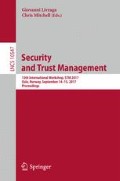Abstract
Insider threats are one of the biggest issues in information management. In practice, the hardest challenge is protecting information assets from malicious insiders. There have been many studies to clarify the factors influencing insiders to perform malicious activities. However, a user study based on a questionnaire cannot be expected to reveal the honest opinions of potential malicious insiders who may give false answers to such studies. In addition, it is hard to observe the comprehensive searches of malicious activities in insider incidents, because available data about incidents are limited. To overcome the difficulties in studying malicious activities in insider threats, we propose a new approach employing epidemiological methodologies with (1) risk amplification, and (2) a logistic model for malicious insiders. We employed a total of 200 subjects from crowd-sourcing services and observed every step that they employed to perform a given task in an environment motivating them to malicious activities (risk amplification). We applied a logistic regression to identify the odds ratio of in favor of malicious activity among those exposed to a factor divided by the odds when not exposed to it. Our experiment shows that a credential shared in group increases the risk of malicious insiders by 3.28 with statistical significance (\(p < 0.1\)).
Access this chapter
Tax calculation will be finalised at checkout
Purchases are for personal use only
Notes
- 1.
- 2.
We plan to make all data publicly available from our website http://windy.mind.meiji.ac.jp/kiknlab2014/paper.html in a way that does not compromise anyone’s privacy.
References
Fagan, M., Khan, M.M.H.: Why do they do what they do?: a study of what motivates users to (not) follow computer security advice. In: Proceedings of 12th Symposium on Usable Privacy and Security (SOUPS 2016), pp. 59–75 (2016)
Rao, A., Schaub, F., Sadeh, N., Acquisti, A., Kang, R.: Expecting the unexpected: understanding mismatched privacy expectations online. In: Proceedings of 12th Symposium on Usable Privacy and Security (SOUPS 2016), pp. 77–96 (2016)
Ion, I.,Reeder, R., Consolvo, S.: “... no one can hack my mind”: comparing expert and non-expert security practices. In: Eleventh Symposium on Usable Privacy and Security (SOUPS 2015), pp. 327–346 (2015)
Leon, P.G., Ur, B., Wang, Y., Sleeper, M., Balebako, R., Shay, R., Bauer, L., Christodorescu, M., Cranor, L.F.: What matters to users? Factors that affect users’ willingness to share information with online advertisers. In: Proceedings of the SOUPS 2013. ACM (2013)
Aurigemma, S., Panko, R.: A composite framework for behavioral compliance with information security policies. In: Proceedings of the 2012 45th Hawaii International Conference on System Sciences, pp. 3248–3257. IEEE Computer Society (2012)
Renaud, K., Goucher, W.: The curious incidence of security breaches by knowledgeable employees and the pivotal role a of security culture. In: Tryfonas, T., Askoxylakis, I. (eds.) HAS 2014. LNCS, vol. 8533, pp. 361–372. Springer, Cham (2014). doi:10.1007/978-3-319-07620-1_32
Hausawi, Y.M.: Current trend of end-users’ behaviors towards security mechanisms. In: 4th International Conference on Human Aspects of Information Security, Privacy, and Trust, pp. 140–151 (2016)
Spitzner, L.: Honeypots: catching the insider threat. In: Proceedings of 19th Annual Computer Security Applications Conference, pp. 170–179 (2003)
Azaria, A., et al.: Behavioral analysis of insider threat: a survey and bootstrapped prediction in imbalanced data. IEEE Trans. Comput. Soc. Syst. 1, 135–155 (2014)
Legg, P.A., et. al.: Caught in the act of an insider attack: detection and assessment of insider threat. In: IEEE International Symposium on Technologies for Homeland Security (2015)
Legg, P.A.: Visualizing the insider threat: challenges and tools for identifying malicious user activity. In: 2015 IEEE Symposium on Visualization for Cyber Security (VizSec), pp. 1–7 (2015)
Greitzer, F.L., et al.: Identifying at-risk employees: modeling psychosocial precursors of potential insider threats. In: 2012 45th Hawaii International Conference on System Science (HICSS), pp. 2392–2401 (2012)
Greitzer, F.L., Frincke, D.A.: Combining traditional cyber security audit data with psychosocial data: towards predictive modeling for insider threat mitigation. In: Probst, C., Hunker, J., Gollmann, D., Bishop, M. (eds.) Insider Threats in Cyber Security. Advances in Information Security, vol. 49, pp. 85–113. Springer, Boston (2010). doi:10.1007/978-1-4419-7133-3_5
Niihara, K., Kikuchi, H.: Primary factors of malicious insider in E-learning model. In: HCI International 2016 - Posters’ Extended Abstracts: 18th International Conference. Proceedings, Part I, pp. 482–487 (2016)
Cohen, L.E., Felson, M.: Social change and crime rate trends: a routine activity approach. Am. Sociol. Rev. 44(4), 588–608 (1979)
Cressey, D.R.: Other People’s Money: A Study in the Social Psychology of Embezzlement. Free Press, Glencoe (1953)
Greitzer, F.L., et al.: Identifying at-risk employees: modeling psychosocial precursors of potential insider threats. In: 2012 45th Hawaii International Conference on System Sciences, pp. 2392–2401 (2012)
Fagade, T., Tryfonas, T.: Security by compliance? A study of insider threat implications for Nigerian banks. In: Tryfonas, T. (ed.) HAS 2016. LNCS, vol. 9750, pp. 128–139. Springer, Cham (2016). doi:10.1007/978-3-319-39381-0_12
Cappelli, D., Moore, A., Trzeciak, R.: The CERT Guide to Insider Threats: How to Prevent, Detect, and Respond to Information Technology Crimes. (Theft, Sabotage, Fraud). Addison-Wesley Professional, Boston (2012)
Cappelli, D., et al.: Management and Education of the Risk of Insider Threat (MERIT): System Dynamics Modeling of Computer System. Carnegie Mellon University, Software Engineering Institute (2008)
Nurse, J.R.C. et al.: Understanding insider threat: a framework for characterising attacks. In: 2014 IEEE of the Security and Privacy Workshops (SPW), San Jose, CA, pp. 214–228 (2014)
Author information
Authors and Affiliations
Corresponding author
Editor information
Editors and Affiliations
Rights and permissions
Copyright information
© 2017 Springer International Publishing AG
About this paper
Cite this paper
Kikuchi, H., Koichi, N., Yamada, M. (2017). How Much is Risk Increased by Sharing Credential in Group?. In: Livraga, G., Mitchell, C. (eds) Security and Trust Management. STM 2017. Lecture Notes in Computer Science(), vol 10547. Springer, Cham. https://doi.org/10.1007/978-3-319-68063-7_7
Download citation
DOI: https://doi.org/10.1007/978-3-319-68063-7_7
Published:
Publisher Name: Springer, Cham
Print ISBN: 978-3-319-68062-0
Online ISBN: 978-3-319-68063-7
eBook Packages: Computer ScienceComputer Science (R0)

